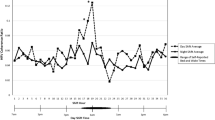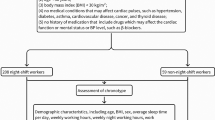Abstract
Purpose
The aim of this study was to determine the effect of circadian rhythm disruption on cardiovascular autonomic regulation by examining potential differences in heart rate variability (HRV) between day- and night-shift workers.
Methods
The study population consisted of 162 workers who worked both day and night shifts in two automobile manufacturing companies who underwent ambulatory 24-h electrocardiogram recording and completed questionnaires and sleep diaries. Both time and frequency domain indices of HRV were compared.
Results
HRV parameters (mean RR, SDNN, RMSSD, pNN50, TP, HF, LF, LF/HF ratio) reflecting sympathetic and parasympathetic modulation varied less with activity in night-shift workers.
Conclusions
Circadian rhythm-mediated changes in autonomic regulation of the cardiovascular system were blunted in night-shift workers, which could contribute to an increased risk for cardiovascular disease in overnight workers.




Similar content being viewed by others
Abbreviations
- Mean RR:
-
Mean RR interval
- SDNN:
-
Standard deviations of all NN intervals
- RMSSD:
-
Square root of the mean squared differences of successive NN intervals
- pNN50:
-
Proportion derived by dividing NN50 by the total number of NN interval
- TP:
-
Total power
- LF:
-
Low frequency (0.04–0.15 Hz)
- HF:
-
High frequency (0.15–0.4 Hz)
References
Akerstedt T (2003) Shift work and disturbed sleep/wakefulness. Occup Med 53(2):89
Bae G et al (2013) Shift work and working time. Korea Labor Institute, Seoul
Boggild H, Knutsson A (1999) Shift work, risk factors and cardiovascular disease. Scand J Work Environ Health 25(2):85–99
Burger AJ, Kamalesh M (1999) Effect of beta-adrenergic blocker therapy on the circadian rhythm of heart rate variability in patients with chronic stable angina pectoris. Am J Cardiol 83(4):596–598. doi:10.1016/s0002-9149(98)00921-7
Burgess H, Trinder J, Kim Y, Luke D (1997) Sleep and circadian influences on cardiac autonomic nervous system activity. Am J Physiol Heart Circ Physiol 273(4):1761–1768
Casolo G, Balli E, Taddei T, Amuhasi J, Gori C (1989) Decreased spontaneous heart rate variability in congestive heart failure. Am J Cardiol 64(18):1162–1167. doi:10.1016/0002-9149(89)90871-0
Costa G (2003) Shift work and occupational medicine: an overview. Occup Med 53(2):83–88
European Foundation (2007) Fourth European working conditions survey. European Foundation for the Improvement of Living and Working Conditions, Doublin
Fallen EL, Kamath MV, Ghista DN (1988) Power spectrum of heart rate variability: a non-invasive test of integrated neurocardiac function. Clin Invest Med 11(5):331
Fleiss JL (1986) The design and analysis of clinical experiments. Wiley, USA
Freitas J, Lago P, Puig J, Carvalho MJ, Costa O, de Freitas AF (1997) Circadian heart rate variability rhythm in shift workers. J Electrocardiol 30(1):39–44
Furlan R et al (1990) Continuous 24-hour assessment of the neural regulation of systemic arterial pressure and RR variabilities in ambulant subjects. Circulation 81(2):537–547
Furlan R, Barbic F, Piazza S, Tinelli M, Seghizzi P, Malliani A (2000) Modifications of cardiac autonomic profile associated with a shift schedule of work. Circulation 102(16):1912–1916
Ha M, Kim J, Park J, Chung HK (2001) Blood pressure and heart rate variability in workers of 8-hour shifts. J Hum Ergol 30(1–2):229–233
Hayano J, Yamada M, Sakakibara Y, Fujinami T, Yokoyama K, Watanabe Y, Takata K (1990) Short-and long-term effects of cigarette smoking on heart rate variability. Am J Cardiol 65(1):84–88
Hemingway H, Shipley M, Brunner E, Britton A, Malik M, Marmot M (2005) Does autonomic function link social position to coronary risk? The Whitehall II study. Circulation 111(23):3071–3077
Huikuri HV, Niemela MJ, Ojala S, Rantala A, Ikaheimo MJ, Airaksinen KE (1994) Circadian rhythms of frequency domain measures of heart rate variability in healthy subjects and patients with coronary artery disease. Effects of arousal and upright posture. Circulation 90(1):121–126
Ito H, Nozaki M, Maruyama T, Kaji Y, Tsuda Y (2001) Shift work modifies the circadian patterns of heart rate variability in nurses. Int J Cardiol 79(2):231–236
Jurca R, Church T, Morss G, Jordan A, Earnest C (2004) Eight weeks of moderate-intensity exercise training increases heart rate variability in sedentary postmenopausal women. Am Heart J 147(5):8–15
Kleiger RE, Miller JP, Bigger JT Jr, Moss AJ (1987) Decreased heart rate variability and its association with increased mortality after acute myocardial infarction. Am J Cardiol 59(4):256–262. doi:10.1016/0002-9149(87)90795-8
Knutsson A (2004) Methodological aspects of shift-work research. Chronobiol Int 21(6):1037–1047
Lehndorff S (2001) Factories with breathing power. The change in working-time organisation in the European automotive industry. In: 8th international symposium on working time, pp 14–16
Malik M et al (1996) Task force of the European society of cardiology and the North American society of pacing and electrophysiology. Heart rate variability: standards of measurement, physiological interpretation, and clinical use. Circulation 93(5):1043
Malliani A, Pagani M, Lombardi F, Cerutti S (1991) Cardiovascular neural regulation explored in the frequency domain. Circulation 84(2):482–492
Malpas SC, Purdie GL (1990) Circadian variation of heart rate variability. Cardiovasc Res 24(3):210–213
McEwen BS (2000) Allostasis, allostatic load, and the aging nervous system: role of excitatory amino acids and excitotoxicity. Neurochem Res 25(9):1219–1231
Meijman TF, Mulder G (1998) Psychological aspects of workload. Handbook of work and organizational psychology: Work psychology 2, Psychology Press Ltd, UK
Minors DS, Waterhouse JM (1986) Circadian rhythms and their mechanisms. Experientia 42(1):1–13
Pichot V, Roche F, Denis C, Garet M, Duverney D, Costes F, Barthélémy J (2005) Interval training in elderly men increases both heart rate variability and baroreflex activity. Clin Auton Res 15(2):107–115
Steenland K, Fine L (1996) Shift work, shift change, and risk of death from heart disease at work. Am J Ind Med 29(3):278–281
Teisala T, Mutikainen S, Tolvanen A, Rottensteiner M, Leskinen T, Kaprio J et al (2014) Associations of physical activity, fitness, and body composition with heart rate variability-based indicators of stress and recovery on workdays: a cross-sectional study. J Occup Med Toxicol 34:26–40
US Bureau of Labor Statistics (2005) Occupational Outlook Handbook. United States Department of Labor
Van Amelsvoort L, Schouten EG, Maan AC, Swenne CA, Kok FJ (2000) Occupational determinants of heart rate variability. Int Arch Occup Environ Health 73(4):255–262
Van Amelsvoort LG, Schouten EG, Maan AC, Swenne CA, Kok FJ (2001) Changes in frequency of premature complexes and heart rate variability related to shift work. Occup Environ Med 58(10):678–681
Zhong X, Hilton Z, Gates G, Jelic S, Stern Y, Bartels M, DeMeersman R, Basner R (2005) Increased sympathetic and decreased parasympathetic cardiovascular modulation in normal humans with acute sleep deprivation. J Appl Physiol 98(6):2024–2032
Conflict of interest
The authors declare that they have no conflict of interest.
Author information
Authors and Affiliations
Corresponding author
Rights and permissions
About this article
Cite this article
Lee, S., Kim, H., Kim, DH. et al. Heart rate variability in male shift workers in automobile manufacturing factories in South Korea. Int Arch Occup Environ Health 88, 895–902 (2015). https://doi.org/10.1007/s00420-014-1016-8
Received:
Accepted:
Published:
Issue Date:
DOI: https://doi.org/10.1007/s00420-014-1016-8




